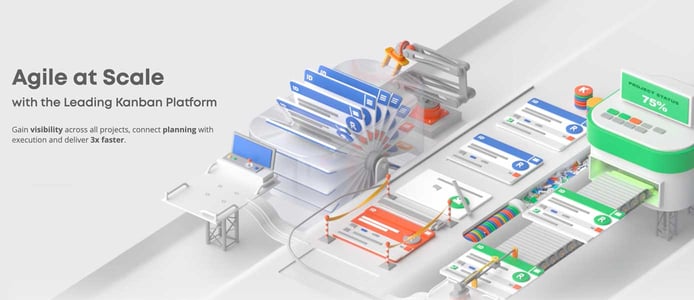
TL; DR: Kanbanize is a cloud-hosted software suite centered on Kanban, a workflow management technique that maximizes visibility and productivity. The agile project and portfolio management tool, available via Software-as-a-Service (SaaS), ensures transparency across the entire organization. Kanbanize’s most recent release helps users optimize project delivery by defining service level expectations — or the maximum amount of time that users should spend on work items in a given process.
Balancing the demands of a typical workday — buzzing with emails, texts, and other distractions — isn’t easy. But, for a shot at success, today’s knowledge workers must shine in their area of expertise while mastering the art of multitasking.
The combination, primarily focused on speed, often puts workers on the fast track to burnout. In various studies, neuroscientists have found that multitasking inhibits creativity, slows mental performance, and leads to stress and anxiety.
The visual workflow method Kanban (pronounced “kahn-bahn”) serves as an answer to this problem. Named after the Japanese words sign and board, Kanban helps counter the urge to multitask, encouraging teams to map out and complete tasks one at a time.
Many organizations use physical boards with sticky notes or cards to create a visual representation of various stages of work items.

But the folks behind Kanbanize have found a better and more collaborative way to implement the method: through a cloud-hosted software suite. The technology provides users with a 360-degree view of all projects to faster product delivery.
“Since the very beginning, the goal of this product and company has been to help people work efficiently and therefore accelerate innovation,” said Pavel Naydenov, Head of Marketing at Kanbanize. “If we can help people organize their work in a better way, we’ve done our job.”
The company’s agile project and portfolio management tool is packed with features, from digital boards and team workspaces to analytics. With the most recent release, Kanbanize even helps users define service level expectations, which allow them to manage the amount of time spent on a given project stage.
Pioneering the Kanban Software Space Since 2012
“Dimitar was sent to the United States by his former employer to become familiar with agile methodologies — which were new at the time,” Pavel said. “He fell in love with Kanban at first sight.”
After returning to Bulgaria, Dimitar got in touch with his childhood best friend, Christo. The pair used the principles of Kanban and lean method to streamline management across multiple teams. The Kanbanize platform was the result.
Pavel said that the company has seen significant growth over the past year and a half. Teams are seeking opportunities to improve efficiency as the ongoing pandemic continues to cast economic uncertainty across markets. In this environment, individuals, teams, and entire organizations are seeking opportunities to improve efficiency.

“We see an increasing number of customers and companies that need tools to communicate in this kind of environment,” Pavel said. “And it’s not only because they want to buy more licenses but also because they want advice or training.”
To help onboard clients, Kanbanize provides detailed yet digestible information on the platform via a free series of tutorials and an extensive guide to getting started with the software. In addition to these online resources, the company provides customer support from a team of experts.
“One of the things that I really love about working at Kanbanize is that we really care about our clients, not just because they give us money, but because we help them do their job better than they did in the past,” Pavel said. “That way, both sides benefit. I think that this is one of the things that make us such a good company.”
Build Transparency Across the Entire Organization
The Kanbanize team has worked tirelessly to evolve its Kanban platform over the years. Pavel told us that 2019 served as a significant turning point for the company.
That year, Kanbanize introduced its Timeline feature, offering a visual and agile approach to planning. With the Timeline, users can see how their plans progress in real time and visualize their execution.
“The concept is that you can see a high-level roadmap of the entire project placed on top of your board,” Pavel said. “You can see your past, current, and future initiatives in a calendar view, and you can see all the sub-tasks that are related — everything, instantly.”
Management and Team Workspaces were the next major additions to the platform, allowing users to distribute and track work across teams and projects from a single pane of glass. The features boost visibility and streamline delegation processes.
“You could create, for example, a management board for the CEO of the company so he can see how each and every single team is related to his board,” Pavel told us. “He can see every project and how it’s going.”
At the end of the day, the cloud-hosted software provides a crystal clear view of operations, aligning strategic planning with execution. In a sense, Kanbanize bridges the gap between the day-to-day work of employees and strategic leadership goals.
The technique is proving valuable to Kanbanize users.
“The software has created a new environment centered around communication and transparency in a visually appealing way that we haven’t seen before,” said Ben Jackman, Logistics Supervisor at BMWC Constructors, in a testimonial.
As with any agile development group, the Kanbanize team strives to maintain a feedback loop with customers to inform future development. “Probably 90% of the product updates are based on what our clients tell us,” Pavel said. “Some of them have been game changers.”
New Feature Addresses Service Level Expectations
Kanbanize’s most recent release includes a new feature centered on service level expectations (SLEs) inspired by user input. “You simply configure your SLEs, and the next time a task enters your workflow from another team, the platform automatically tells you how much time you have to finish the work,” Pavel said.
As businesses grow, platforms like Kanbanize become increasingly important to connect siloed departments within the broader enterprise. In some cases, enterprises become so large that they’re essentially a group of individual small businesses. Tools like Kanbanize make it possible for employees to communicate and collaborate across vast business infrastructure.
“Our mission is to provide transparency to the whole company,” Pavel said. “The goal is really to provide them with a tool to create transparency, and everyone can see the projects that are going on. And we genuinely believe that this is the way people can improve.”
Unity is the ultimate goal of the Kanban method in general, Pavel said.
“If one company consists of different services, then all these services must communicate with each other inside the company. And the only way to do that is to make everything visible and transparent.”
HostingAdvice.com is a free online resource that offers valuable content and comparison services to users. To keep this resource 100% free, we receive compensation from many of the offers listed on the site. Along with key review factors, this compensation may impact how and where products appear across the site (including, for example, the order in which they appear). HostingAdvice.com does not include the entire universe of available offers. Editorial opinions expressed on the site are strictly our own and are not provided, endorsed, or approved by advertisers.
Our site is committed to publishing independent, accurate content guided by strict editorial guidelines. Before articles and reviews are published on our site, they undergo a thorough review process performed by a team of independent editors and subject-matter experts to ensure the content’s accuracy, timeliness, and impartiality. Our editorial team is separate and independent of our site’s advertisers, and the opinions they express on our site are their own. To read more about our team members and their editorial backgrounds, please visit our site’s About page.

